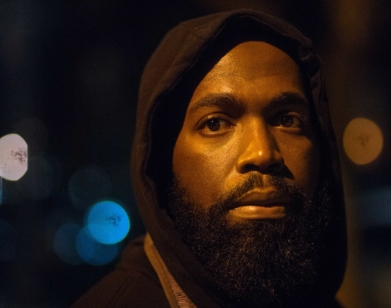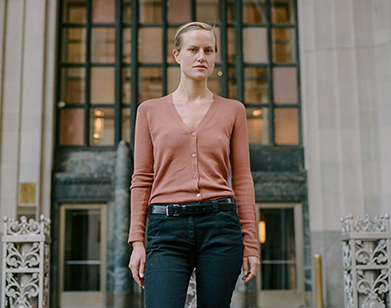Glitch artist Chris Dorland talks transhumanism with author Carolyn Kane
There’s something inscrutable yet familiar about Chris Dorland’s art. Colors and pixels hemorrhage from layers of images that dissolve into one another in mesmerizing, machine-made compositions. It’s like the glitchy glow of a television screen when the VHS tape runs out, a glimpse of hyperreality transposed into two dimensions. Civilian, Dorland’s latest show on view at Lyles & King through February 11, features nine Alumacore panels and five video screens in an immersive installation.
Each creation comes from what the New York-based artist calls his laboratory: Dorland’s studio consists of printers, scanners, and machines—some obsolete and many outdated—that consume, process, and manipulate images, which Dorland then fragments and synthesizes.
Dorland was largely influenced by Carolyn Kane’s book, Chromatic Algorithms: Synthetic Color, Computer Art, and Aesthetics after Code, which delves into the history and philosophy of computer-generated color and its effects. Kane, a professor at Ryerson University in Toronto who completed her PhD at New York University and a Postdoc in aesthetics at Brown University has a forthcoming book, Precarious Beauty: Glitch, Noise, and Aesthetic Failure, which aligns with much of Dorland’s current work. Dorland, struck by her writing, reached out to Kane last summer and the two met over coffee. They reunited in New York last week to discuss Civilian.
CHRIS DORLAND: There are so many concepts in [Chromatic Algorithms] that I had never heard articulated before. Actually I was thinking even with the book, “Oh god, there’s so much information it would be so amazing if I could just upload this thing to my brain.”
CAROLYN KANE: [laughs] Thank you. I try to always teach production classes because I like bringing the theory and ideas to students who are making work so they can articulate what they’re doing. I really enjoy that as opposed to writing high theory for other people who write theory.
DORLAND: I find it’s very readable. Like the history of glitch art or [Friedrich] Kittler, and the Aesthetics of Interference. It’s something I feel like I could really relate to: to take technology and filter it through different processes, to create chaos. And then to have that described as an aesthetic thing—an interference—I feel like that’s 100 percent what I do.
KANE: Let’s talk about your show. There are a few videos and a few still images that are printed on Alumacore, right?
DORLAND: The images are all assembled in the studio and the process is both digital and analog. It’s kind of like an image laboratory where I have various technologies, some broken, some functional, and I’m filtering things through layers and iterations to get to one digital image in the end.
KANE: Why Alumacore?
DORLAND: I wanted a really inorganic material—something that referenced technology. And the blackness … I think of reflective blackness as the material of technology, or at least the exteriorized form. It’s this black screen but also a kind of abyss—something that’s totally impenetrable and also kind of seductive. Like Darth Vader.
KANE: I was thinking, when I was looking at your work yesterday, about tension between control and technological immersion. There’s a play between the two where there’s a flirtation with error, with technological breakdown. Yet because it’s a representation, it’s only the veneer of chaos and the veneer of being out of control because the artist is making meticulous, decisive choices to control how noise appears and for how long, on what loop, and when to cut it.
DORLAND: I try to interfere as little as possible [with the scanning processes]. As it stands, I already feel like my role is that of a facilitator. I think of the event being the scan, and how can I set it up so that the machine is doing its own thing and take more and more of my own agency out of it?
KANE: So you see yourself more aligned with chance?
DORLAND: I think that’s an element in trying to let the machine do as much of the work as possible. One of my favorite moments in these pieces is where the ink gobs up on the printer that leaves streaks and traces. I cherish those moments that literally no one has control over. I’d say the chance element is for sure something I like and would like to see. I really look forward to expand just exactly what machine vision looks like. Machines are increasingly seeing the world—that’s really interesting to me.
KANE: What you’re saying reminds me of a chapter from my most recent book about Edward Burtynsky, who does aerial photography and views of largely panoramic—
DORLAND: Does he use satellites?
KANE: No, he goes on helicopters. But, see, technology is necessary to produce this view of the world. Or I think of us going to the moon and looking back onto the earth as one of the first movements towards that mechanized, machine-mediated vision of ourselves and how we understand ourselves in a machine age. These errors and paint blobs are mechanically produced chance occurrences but also within parameters of what’s possible. Because the human aspect comes back into it when you say, “Oh, I like that blob.” I think that balance is always crucial in aesthetics. Maybe that is also at the same time allowing those happy accidents to occur. Like programmers, artists are setting up the parameters, the conditions of possibility of what can happen.
DORLAND: And I think of that being what my goal is as an artist.
KANE: You were making a joke before about being scared to open the app that tracks how many times you use your phone each day. I find that that fear and seductiveness of technology really interesting.
DORLAND: How would you feel if the option presented itself to sort of connect something into your brain? If in the next five years there was a new device that required some kind of implant where the outcome would be incredible, would you be open to doing that?
KANE: I’d need to see what the tradeoff is. My acupuncturist [laughs] was saying that you can harvest your stem cells and science now lets you put it back in when you’re older. She said she’d do it when the price comes down. [laughs]
DORLAND: True to form as a consumer. [laughs]
KANE: [laughs] So I don’t know. See, I don’t even like this big TV [gestures to television]. I just want to watch downloads on my laptop, you know?
DORLAND: But I would say that that’s even more contemporary—to want to be in bed with your device on you, touching you physically. That’s what I see as being the big transition: from the home computer and the big TV to being the thing that’s permanently on your body and will ultimately end up in your body. Do you not read a lot of fiction?
KANE: I don’t read any fiction. I’m now [working on] a history of electricity in public space. I’m thinking of signs, like advertising signs and consumer culture, as totally fueled by electricity. Again, this idea of technology merging with public space and consumer culture. I think I’m going to focus on New York.
DORLAND: As a person who lives in New York—I live in Chelsea, and to me I feel like I’m in a hyper-real, 21st century utopia. But there are the ecological costs and there’s such a dark side that allows that to happen, whether its wars that are waged in other countries or whether its environmental things that we are starting to feel the effect of.
KANE: If we think about when we go on our cell phones and computers, the engineers of the program have made it so that we don’t see layers of buffering and errors unless it starts to break down—and that’s what your work is showing right? It’s stuff that’s kept out of view come back into the foreground of our experience of technology. In the same way it’s an analogy to this consumer culture where we see everyone spending hundreds of dollars for these shiny-shiny everythings. It all gets thrown out and the obsolescence is going faster and faster so more and more stuff is getting shipped back to China and India, more plastic wasted, more ecological effects—this is the glitch. This is the error, the trash of the culture.
DORLAND: And what you just described is something that I’ve wanted the work to do, which is like a screen when you crosscut it. The idea of an image is that you’re not supposed to see how it’s made. I think a lot of us don’t even understand the technology that we’re using. The concept of the cloud is this thing up in the sky when actually it’s servers all over the country that are sucking power and taking up a lot of resources. I think of my role and what my work is about and it’s really trying to make the invisible visible.
CIVILIAN IS ON VIEW AT LYLES & KING IN NEW YORK CITY UNTIL FEBRUARY 11, 2018.






